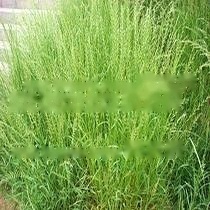
Chinese name: ryegrass
Latin name: Lolium perenne L.
Distribution area: distributed in Kashmir, Pakistan, Europe, warm temperate Asia, Africa Northern
Family and Genus: Poaceae ryegrass
English name: Perennial ryegrass
1. Morphological characteristics of ryegrass
Black Wheatgrass is a perennial plant with a stalk height of 30-90 cm and soft roots on the basal nodes. Ligule ca. 2 mm; leaf blade soft, pubescent, sometimes with auricles. Spike-shaped spikes erect or slightly curved; rachis smooth and glabrous; glume lanceolate, margin narrowly membranous; lemma oblong, herbaceous, smooth, apex awnless; short cilia on both ridges. Caryopsis are about 3 times as long as they are wide. Flowering and fruiting period May-July.
2. Growth habit of ryegrass
Ryegrass is an excellent forage commonly introduced and cultivated in various places. Born in meadow meadows, common in roadside wetlands. Ryegrass likes cool and humid climates. Suitable for growing in areas with cool summers and not too cold winters. It can grow well at about 10°C, below 27°C is suitable for growth, and 35°C is poor for growth. Strong light, short sunshine and low temperature are beneficial to tillers. If the temperature is too high, tillering will stop or die in the middle. Ryegrass has poor cold and heat resistance, and is not shade-tolerant. It can grow for more than 2 years under suitable terroir conditions, and is generally only used as an over-the-year forage in China.
3. Planting method of ryegrass
The seeds of ryegrass are small, so it is necessary to prepare the ground carefully before sowing, so that the land is leveled, the clods are finely broken, and good soil moisture is maintained. It should be planted in a place with fertile soil and convenient irrigation and drainage, and sufficient base fertilizer should be applied during land preparation. Adequate water and fertilizer is a key measure for perennial ryegrass to exert its production potential, and the effect of nitrogen fertilizer application is particularly prominent. The perennial ryegrass can be sown in spring or autumn. Spring sowing is appropriate in mid-to-late April, and autumn sowing is from the end of autumn to mid-October. Immediately irrigate after sowing on sunny days, but the water cannot flow over the surface of the box. Special attention should be paid to keeping the soil moist during the seedling stage and before tillering, and irrigate every 3 to 6 days.
Guess you like it
Salvia | Cistanche | | Edelweiss| Cosmos|
Syringa | Venus flytrap| Wild strawberry| Cistanche|
gerbera | white grass | dendrobium | shegan | purple jasmine | duruo | zhe fritillary | petunia |
![[Dog Training 5] The training method of pet dog dining etiquette](/static/img/12192/12192_1.jpg)




